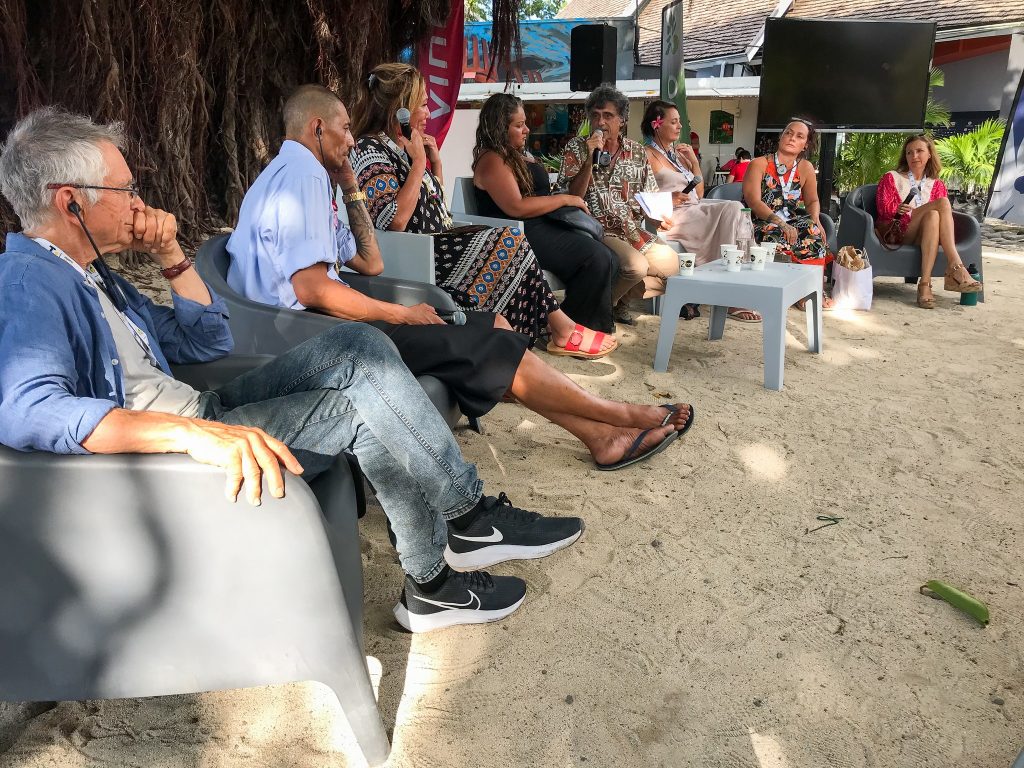This question has been asked at every edition of the FIFO over the past twenty years.
Telling the others story and telling one’s own story: what is the place of indigenous storytelling in documentary creation? To discuss this question, the FIFO organized a round table with professionals from the audiovisual world.

Who may tell Oceanian stories? How do Oceanians make the the narrative their own? How can they tell their stories? These questions have been asked many times over the years, by FIFO participants and by professionals in the audiovisual field. Today the festival puts the question on the table and unambiguously opens the debate. It will be discussed by directors, producers, and actors of Oceanian and Western origins. The debate begins with a question: who is the other? “We are often the other, especially when we are female with brown skin. Today, we’re trying to catch up with these images, but it’s hard … We see how an exotic image of brown-skinned women is shown, we’re constantly countering this very popularised image,” says Lisa Taouma, creator of Coconet TV, a web platform that brings together stories from the islands of Oceania and is an important window into the region. Tom Zubrycki is an Australian director who won an award at FIFO 2012 for his film The Hungry Tide, he offers another perspective: This white-skinned man describes himself as a migrant, since his family arrived in Australia from the European continent, so he too has sometimes felt like “the other”. “My films are a consequence of that! I can put myself in the place of the other… As a filmmaker, you have to be able to do that, to be that person and try to penetrate their consciousness to understand their life. So, even if I sometimes feel like the “other” because I am typically European, that doesn’t mean I can’t find stories to tell, and have an intimate relationship with the participants. I don’t want to make films about them, but with them. Today, it will become more and more difficult for non-indigenous people to tell indigenous stories.
Structures dedicated to indigenous people
It must be said that for a long time, Westerners have been telling the stories of indigenous peoples. If this is still happenning, the way of telling these stories has already taken another direction, Polynesians, Melanesians and Micronesians are reacquiring their history and starting to tell it. The road to get there has not been without its pitfalls, the battles have been tough, the blows too, but success is there, at the end of the road. “We’ve created a chain for the aboriginal peoples. And if other people want to come with us, that’s great, but it’s Aborigines by Aborigines about Aborigines,” says Anusha Duray, program director of NITV, Australia’s indigenous public television. Structures such as television channels or production companies have emerged over time, they have managed to make a place for themselves in the audiovisual landscape: An important and necessary place, a place to tell one’s story in complete security. “For a long time, the financing structures asked us to tell stories for their audience. We had to comply. It’s only now that we have the right to do things for our audience. We don’t have to make films for white people anymore, we make them for ourselves,” adds Anusha Duray. This change is essential for indigenous people. Telling one’s story through a documentary, offering one’s perspective, reclaiming the narrative has other virtues as well. “It’s very important how you tell the story, and how you make a documentary, because there is the power of culture, of traditions and of what is not said. In fact, we educate ourselves,” said Nina Nawalowalo, Fijian director and author of the film A Boy Called Piano, included in the official selection of this 20th FIFO. A 20th festival that will have opened the debate and made things clear, once again.
BOX / Nga aho whakaari, an organization for Māori in the audiovisual industry.
Supporting and telling Māori stories by Māori. That’s the goal of Nga Aho Whakaari, an organization founded thirty years ago in New Zealand. It was a necessity when the indigenous language was neither studied in school nor spoken on television. “A lot of work has been done by many people and generations. And I am lucky enough to carry this legacy, it allows us to open up opportunities for our people to tell our stories,” says Lanita Ririnui, executive producer of the organization which is composed of several members, who all have their role. “We work with culturally competent people to help with our understanding before we go on location. Today, it’s not possible to just walk in anywhere with a camera. You have to go and build the relationship, you need reciprocity, understanding and mutual agreement“. At Nga Aho Whakaari, we discuss projects, subjects, ways of telling stories, ways of filming or producing, but also ways of using the Maori language. This organization accompanies young Maori at each step with a strategy based on three key ideas: Who is the person telling the story? How to do it? and finally, how to think about self-determination. These are essential reflections to move forward in the process. “We want to help youth express their visions. We have a lot of factual stories. That’s important because it’s easy to get trapped by our traumas and issues, we offer an opportunity to break away from them.“
Suliane Favennec – FIFO
